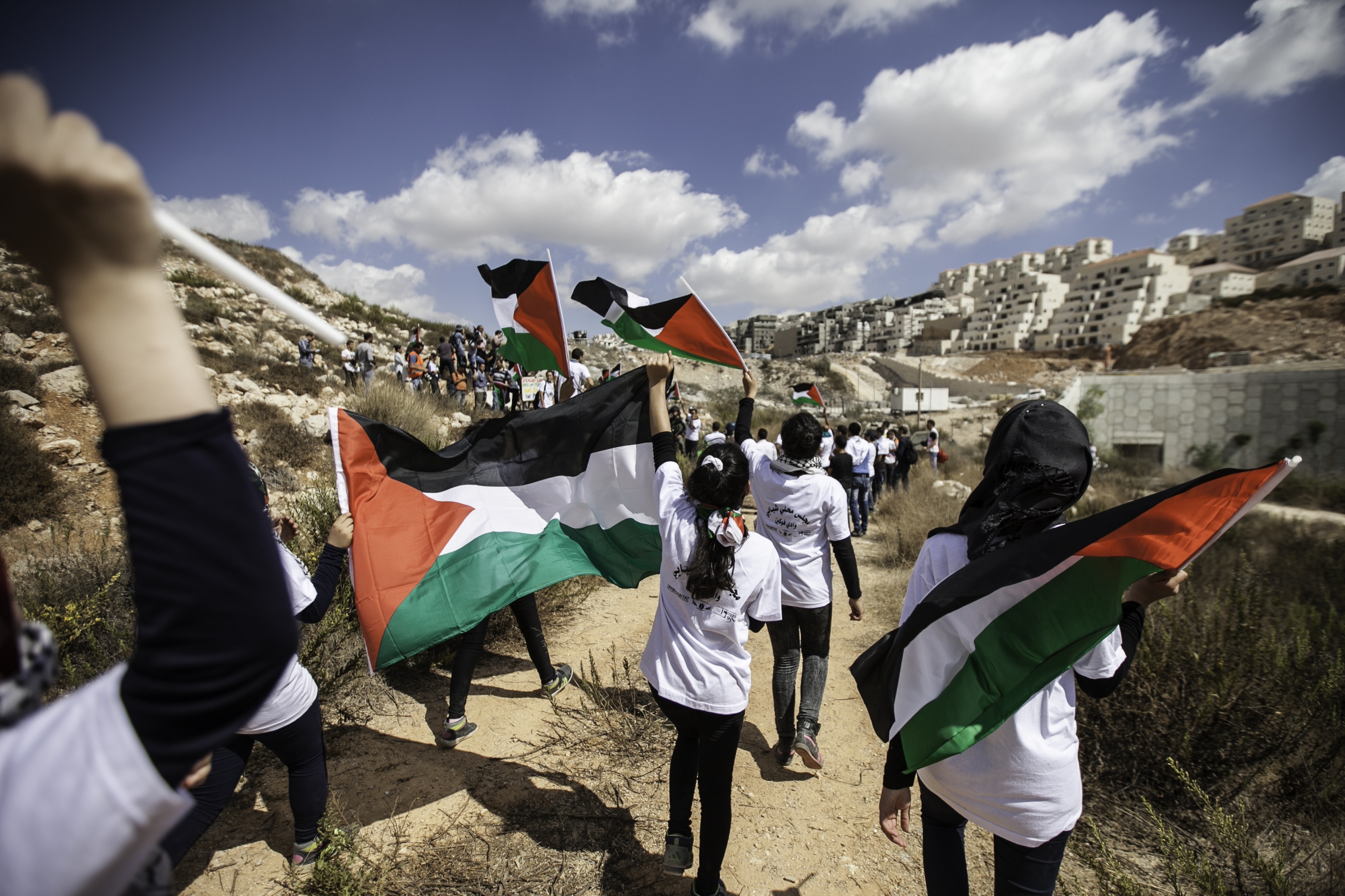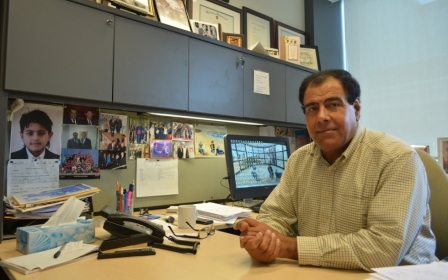Photos: Wadi Fukin residents: 'This is our land'

Wadi Fukin may be the smallest of the five villages threatened by what international organisations are terming Israel’s latest land confiscation, but these days it’s certainly not the quietest.
Leaders in the village of approximately 1,250 people have galvanised locals into organising Friday demonstrations against Israeli occupation for the first time in years, after 4,000 dunams (nearly 1,000 acres) in the southern West Bank was declared “state land” by Israel.
Over a quarter of the confiscated land belongs to Wadi Fukin, which has already lost most of its property to the expanding Israeli settlements of Beitar Illit and Hadar Beitar in the north, and Tsur Hadassah in the west, following the start of the occupation in the West Bank in 1967 by Israel.
“They are planning to make us an island with the settlements surrounding us on all sides,” said Ahmad Sokkar, head of the village council. He lamented the effect occupation has had on the small farming community, citing armed settlers who come to picnic in the village’s only playground, or swim in the reservoirs used to irrigate crops.
“These days we are working in two ways. First within the law and the courts. Second, we are protesting to send a message to everyone – settlers, Israelis, Arabs – to show them how we live in Wadi Fukin.”
Unique history
Sandwiched in a fertile valley between the Green Line and the nearby settlements, Wadi Fukin bears this recent blow in the context of a unique history. After sustaining multiple raids in 1948 by the Zionist paramilitary group, Haganah, among others, Israeli forces completely destroyed Wadi Fukin in the early 1950s, with most locals fleeing to Jordan and nearby Dheisheh refugee camp.
In an exceptional circumstance, villagers were given permission to return to their land and rebuild in 1972 by Israeli authorities, and have since successfully restored and repopulated the village. It currently falls within areas B and C, land under de-facto Israeli military and civil control.
On 31 August, four days after the Gaza ceasefire, residents of the Palestinian villages of Husan, Nahalin, Surif, Jabah and Wadi Fukin found dozens of yellow placards in Hebrew and Arabic, delineating the boundaries of the 4,000 dunams of Israeli “state land”. Seen by many as an effort to placate criticism from the right of how he handled the assault on Gaza, Netanyahu announced the policy to a flurry of international condemnation. This land confiscation is the largest of its kind in three decades.
The five affected villages surround what is left of the Bethlehem governorate, some of the most aggressively settled land in the West Bank. Plans for this land include construction on a new settlement, Gvaot, and allow for unimpeded passage for Israelis from the Gush Etzion settlement bloc to Jerusalem.
The Israeli Coordinator of Government Activities in the Territories (COGAT) maintains the areas recently confiscated were processed under the “rule of law” and is “entirely different from expropriation of land”.
The COGAT, a unit established within the Israeli Ministry of Defence that administers the civil authority in the West Bank insists its methods are sound.
“Before declaring a particular piece of land as government property, the local authorities perform in-depth and precise studies of the lands specified for declaration; in the framework of these studies, the status of the land is checked, as are the uses of it over the years; at the end of the process, only lands which meet the strict standards of the law are declared as government property, while lands which can be assumed to be privately owned are not declared as government property.”
Palestinians can indeed file appeals within the first 45 days, but they will ultimately be heard in military courts, where the vast majority of cases result in upholding the Israeli government’s original claim.
The Gush Etzion Regional Council, a civil organisation run by Jewish-Israeli settlers, has been pushing for residential development in the area since the late 90s. Speaking to the Jerusalem Post, council head Davidi Perl, linked the kidnapping and murder of three Israeli teenagers in June, allegedly by Palestinians, to the appropriation of land.
“Our response is to strengthen the settlement enterprise, strengthen our sovereignty over Gush Etzion and Judea and Samaria, and to build within and without the settlement blocs,” he said.
Friday protest
As is typical for Friday demonstrations throughout Palestine, the first protest began after midday prayers at the village mosque on 5 September. Israeli soldiers and border police had already been positioned for over an hour on the hill where the action was to take place.
The craggy hillside had been allotted to the village’s only school, to be used as space for a playground or additional classrooms. If the land is developed, locals worry for their students’ safety, with settlers in such close proximity, and Sokkar anticipates a daily presence of soldiers not unlike what schools in the neighbouring village of Al Khader face.
A group of teenage girls had planted a Palestinian flag on the parcel of land before Israeli authorities removed it. Activists opted for a more permanent symbol that first Friday, painting flags on to stones, while others dispersed in groups, digging holes into fertile ground and planting olive tree saplings while soldiers attempted to block their efforts.
The group that pushed the farthest up the hillside was a pack of 12-year-olds who successfully challenged and dismissed a soldier trying to obstruct them.
“Ardna!” they yelled. “This is our land.”
Eventually, a middle-aged activist was grabbed by border police and Sokkar attempted to de-arrest him, but not before being pepper-sprayed in the face. Soldiers released the activist but began firing tear gas and sound grenades towards the group of roughly 80 participants.
For at least an hour following the protest, Israeli military and border police fired canisters directly into the village where locals scrambled to deal with the unfamiliar effects of tear gas.
Forty-year-old Nejah Manasra was present at the demonstration with her three children safe at home. As they clamoured to see the commotion from their balcony, she screamed at them across the valley to go inside.
“It’s the first time this has happened in our village. We are a peaceful village. We are a small village and you see the Israeli homes next to ours. We don’t attack them. But the Israeli [soldiers] were preparing themselves for this and waiting for a moment to attack us,” she said.
Before Israeli forces evacuated the area, they uprooted the saplings from the ground and confiscated them, along with signs reading, “Stealing land makes you a thief, not a partner for peace.”
“Our message was peaceful, that this is our land. It is our right to use it, to cultivate it,” said Sokkar. “Every Friday we will have a demonstration and wherever there is a land grab, they should do the same.”
The following week, on 12 September after midday prayers, a similar crowd gathered, this time headed towards the farmland near Beitar Illit’s sewage system, which frequently dumps wastewater into a portion of the valley where farmers cultivate the fruits and vegetables Wadi Fukin is known for.
Activists chanted in English, “one-two-three-four-occupation-no-more,” while Israeli settlers watched. Several soldiers and border police followed from a comfortable distance.
A horde of boys scaled the hill and painted additional flags, occasionally whistling at the soldiers on the adjacent hill. There was no direct confrontation with Israeli forces, but the same group of teenage girls that had planted the original flag two weeks prior came to join the procession as it made its way back to the village.
“Palestine is free! Wadi Fukin is free!” they yelled towards the settlement.
Long after most activists returned home, the group of youths stayed, wrapping themselves in keffiyehs, chanting and pulling stones and debris on to a dirt road to blockade a possible advancing Israeli jeep.
News of the Friday protests in Wadi Fukin has spread - 26 September witnessed the largest crowd of demonstrators yet, with Palestinian, Israeli and international activists again attempting to reach the disputed land before Israeli authorities unleashed their standard formula of crowd dispersal weapons.
“If we don’t go there, who is going to look at us? They have to see us,” said 15-year-old Bera’a Manasra, whose home, like most in Wadi Fukin, has a sprawling view of Beitar Illit.
It’s not yet clear how long the protests will continue, but unsurprisingly, the youth seem the most passionate.
“This is our land. And we saw what happened in Gaza. Of course we will come back next Friday,” said Bera’a.
Fifteen-year-old Baitul sits next to her, “I will never leave,” she said.
New MEE newsletter: Jerusalem Dispatch
Sign up to get the latest insights and analysis on Israel-Palestine, alongside Turkey Unpacked and other MEE newsletters
Middle East Eye delivers independent and unrivalled coverage and analysis of the Middle East, North Africa and beyond. To learn more about republishing this content and the associated fees, please fill out this form. More about MEE can be found here.




